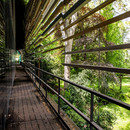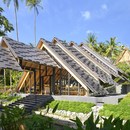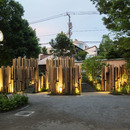Biography
Born in Yokohama in the Kanagawa prefecture, Kengo Kuma (1954) is considered one of the most significant contemporary Japanese architects.After graduating from the University of Tokyo (1979), he studied at Colombia University for two years as a visiting researcher (1985-86).
In 1987 he founded the Spatial Design Studio (now Kengo Kuma & Associates) and opened his Paris Studio in 2008.
His design vision expresses the emotional content of materials, linked to intrinsic characteristics in construction and the teachings of Japanese traditions.
“Almost tuning in” to the materials themselves, Kuma has for years “engaged in a serious critique of what is defined as the “concrete method of construction”, in his desire to find an alternative to this material that “dominates” the world (Treccani).
Projects such as the Stone Museum (2000) and Ando Hiroshige Museum (2000), both in Nasu, in the Tochigi Prefecture, the Takanezawa Plaza, Shiotanigun (Tochigi, 2006) and Suntory Museum of Art, Tokyo (2007) are exceedingly relevant to fully grasp his design philosophy. More recent, small-scale yet highly significant projects include places for meditation constructed of wood, such as the Taoist Temple at Hsinchu (Taiwan, 2018) and Meditation House, Krun (Germany, 2019).
In his book, Anti-object: The Dissolution and Disintegration of Architecture (2008), Kuma criticizes the excessive “objectification” that pervades Western architecture and prevents us “establishing a healthy relationship with the outside world”. At the same time, however, he suggests “an alternative form of architecture (...) preferable and possible”.
In addition to wood, Kuma often favors using “alternative” materials including stone, ceramics, bamboo, plastic and vinyl. In fact, the most evident and marked design innovation in Kuma’s projects is his deeply rooted relationship with Japanese tradition.
Fundamental to his body of work is the use of light, with which he tries to achieve a feeling of “spatial immateriality” by using natural materials or glass. The Plastic House (2002) and Asakusa Culture Tourist Information Center (2012), both in Tokyo, and the Fonds Régional D’art Contemporain (FRAC), Marseilles (2012) are clear examples of this perspective, the latter featuring distinctive facades covered with semi-transparent glass panels.
In fact, his acclaimed, expressive “embellished” facades are indicative of his distinctive architectural features. The Wuxi Vanke Complex (2014) and Hongkou Soho skyscraper, Shanghai (2015) are obvious examples.
For Kuma, studying the site is essential to integrate a project within its surroundings, so that it will not disturb the balance and also appears naturally derived.
Practical examples of this are the Great (Bamboo) Wall House, Peking (2002), Yusuhara Wooden Bridge Museum, Tarougawa (2010) and Cité des Arts et de la Culture, Besançon (2012).
One of the buildings which best represents his architectural vision is however the Water/Glass House, Atami, Japan (1995), a guesthouse built facing the ocean, strongly influenced by the "Hyuga" Villa. This unique project by the German urban planner Bruno Taut (1880-1938), which still exists in Japan today, was constructed during his sojourn in the Eastern country during the 1930s.
Taut had admired and studied the extraordinary17th century Imperial Villa in Katsura and reflected this in his Hyuga Villa, “filtered through one’s European sensibility” (M. Melis). Kuma, with the Water/Glass House, created a structure “that floats in a tank filled with water which cascades from the roof”, blurring the contours of the building with the ocean, not merely framing it, but actually inserting it into nature itself.
As Kuma himself stated, the construction therefore becomes a total environment in which everything dissolves, where there is no fragmentation of spaces, where boundaries disappear”.
Over the years, alongside his practical and theoretical work, Kuma has had a long academic career. Currently professor at the University of Tokyo, he has also taught at Colombia University, the University of Illinois and Keio University.
Numerous awards include the Architectural Institute of Japan (1997), Spirit of Nature Wood Architecture Award, Finland (2002), International Architecture Award for the Best New Global Design (2007), and the honorary title Officier de l’Ordre des Arts et des Lettres della Repubblica Francese (2009).
Kengo Kuma selected works and projects
- New exhibition center Forest Edge, Strasburgo (Francia), 2022
- Osservatorio Nihondaira Yume Terrace, Shizuoka (Giappone), 2019
- Zuishoji Temple, Tokyo (Giappone), 2019
- Suspended Forest, Montricher (Svizzera), 2019
- Edificio polifunzionale Portmix, Shanghai (Cina), 2019
- Tempio buddista Jodo Shu Ichigyo-in, Shinjuku, Tokyo (Giappone), 2019
- Meditation House, Krun (Germania), 2019
- Appartamenti Niwa, Vanves (Francia), 2019
- Wangjing B-15 Project, Pechino (Cina), 2019
- We Hotel TOYA, Toyako, Hokkaido (Giappone), 2018
- Terminal Xiangcheng Yangcheng Lake Tourist Transportation Center, Suzhou (Cina), 2018
- Museo V&A, Dundee (Scozia), 2018
- Tempio Taoista, Hsinchu (Taiwan), 2018
- Stazione ferroviaria Yunoeki Oyu, Akita (Giappone), 2018
- Teatro Misono-za, Aichi (Giappone), 2017
- Grattacielo Hongkou Soho, Shanghai (Cina), 2015
- Complesso residenziale e commerciale Sanlitun Soho, Pechino (Cina), 2010
- Scuola materna Taiyogaoka Hoikuen, Ishikawa (Giappone), 2013
- FRAC Fonds Régional D’art Contemporain, Marsiglia (Francia), 2012
- Asakusa Culture Tourist Information Center, Tokyo (Giappone), 2012
- Cité des Arts et de la Culture, Besançon (Francia), 2012
- Starbucks cafè, Fukuoka (Giappone), 2011
- GC Prostho Museum Research Center, Kasugai-shi (Giappone), 2010
- Casalgrande ceramic cloud, Casalgrande, Reggio Emilia (Italia), 2010
- Yusuhara Wooden Bridge Museum, Tarougawa (Giappone), 2010
- Museum of Kanayama Castle Ruin, Ota, Gunma (Giappone), 2009
- Shopping centre e spazio polifunzionale Sanlitun Village South (Taikoo Li Sanlitun), Pechino (Cina), 2008
- Riconversione di una vecchia fabbrica di orologi Z58, Shanghai (Cina), 2006
- Casa Lotus (Giappone), 2005
- Nagasaki Prefecture Art Museum, Nagasaki (Giappone), 2005
- Spazio LVMH, Osaka (Giappone), 2004
- Casa di plastica, Tokyo (Giappone), 2002
- Great (Bamboo) Wall House, Pechino (Cina), 2002
- Hiroscige Ando Museum, Batou (Giappone), 2000
- Water/Glass House, Atami, Shizuoka, (Giappone), 1995
- Osservatorio Kiro-san, Ehime (Giappone), 1994
Official website
www.kkaa.co.jp
Related Articles: Kengo Kuma
Related Articles









